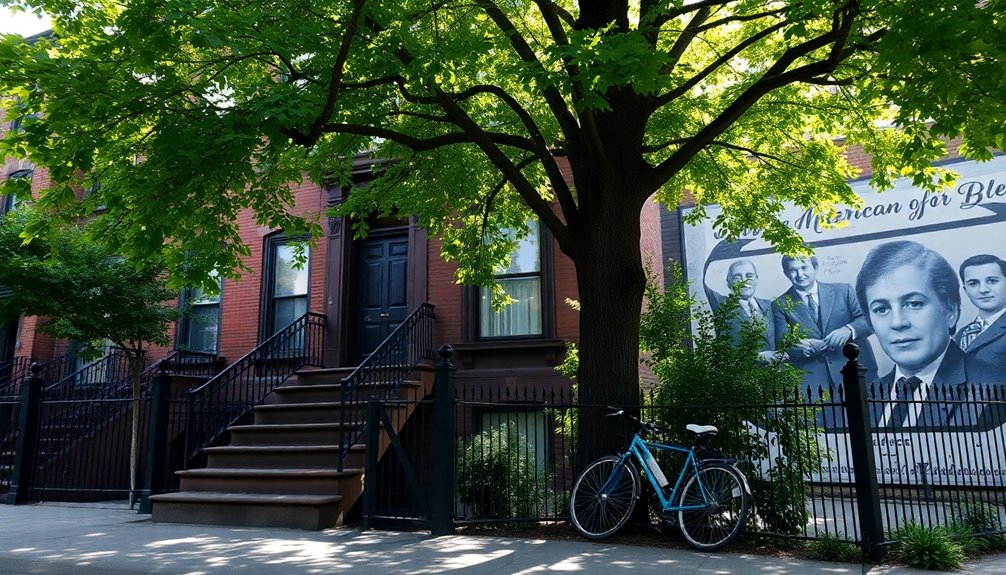*A Tree Grows in Brooklyn* invites you into the heart of early 20th-century America, illustrating the struggles and dreams of immigrant families through Francie Nolan's eyes. You'll witness her resilience against poverty and her relentless pursuit of education amidst harsh realities. The novel captures key themes of family dynamics, identity, and the American Dream, all set against the gritty backdrop of Brooklyn life. Its global impact continues to spark conversations about socio-economic challenges and the human spirit. If you're curious about how these themes resonate today, there's much more to uncover.
Definition of the Great American Novel

The Great American Novel is a concept that captures the essence of American life through its portrayal of ordinary emotions and experiences. It reflects the diverse tapestry of the nation, showcasing how individuals navigate their lives amidst challenges.
You might recognize *A Tree Grows in Brooklyn* as a quintessential example of this genre. Betty Smith's work explores deeply into themes of resilience and poverty, illustrating the struggles and triumphs of its characters as they pursue the American Dream. The narrative also highlights the impact of immigrant experiences on shaping identity and aspirations within the American landscape. Additionally, the story resonates with the importance of hidden contributions that often go unrecognized in the broader historical narrative. Just as Louis Zamperini's survival story exemplifies the power of human resilience, Smith's characters demonstrate the same spirit in their quest for a better life.
The definition of the Great American Novel isn't fixed; it varies based on personal perspectives and experiences. Some may think of Mark Twain's *The Adventures of Huckleberry Finn* or Harper Lee's *To Kill A Mockingbird* as more fitting examples.
Yet, what unites these narratives is their focus on the human condition, the essence of what it means to be American. Each story, including *A Tree Grows in Brooklyn*, offers a lens through which you can understand the complexities of life in America.
Ultimately, the Great American Novel invites you to reflect on your own experiences and emotions, bridging the gap between classic literature and contemporary life.
Overview of the Novel
In *A Tree Grows in Brooklyn*, you'll find yourself immersed in the gritty realities of early 20th-century Brooklyn, where poverty shapes the lives of the Nolan family.
As you follow Francie's journey, you'll encounter richly developed characters that embody the struggles and aspirations of their time. The themes of the American Dream, social class, and evolving gender roles resonate throughout the narrative, creating a powerful backdrop for Francie's coming-of-age story. This exploration of social injustice parallels the struggles faced by families like the Joads in *The Grapes of Wrath*, emphasizing the relevance of migrant worker experiences in shaping American society. Like the Joads, Francie's family exhibits resilience in the face of hardship, highlighting the enduring human spirit. The novel's portrayal of class struggles reflects the social realities of its time, drawing parallels to Dickens' exploration of similar themes in *David Copperfield*.
Setting and Time Period
Set in early 20th-century Brooklyn, *A Tree Grows in Brooklyn* immerses you in the vibrant yet challenging life of the Nolan family during the 1910s and 1920s. The novel begins in 1912, as you follow young Francie Nolan's journey through the struggles of her impoverished neighborhood in Williamsburg. This setting captures the harsh realities faced by immigrant families, who grapple with daily challenges while nurturing their dreams for a better life.
Smith vividly portrays the tenement buildings and narrow streets, reflecting the diverse community shaped by Irish, German, and Jewish influences. You can almost feel the weight of social change in the air, as characters navigate a world transforming under the pressures of World War I and the looming Great Depression.
These historical elements profoundly impact the Nolans' experiences and aspirations, grounding their story in a specific time and place. Through Francie's eyes, you witness the resilience and determination of her family, making the backdrop of early 20th-century Brooklyn an integral part of their narrative.
The setting not only frames their struggles but also highlights the broader themes of hope and perseverance amid adversity.
Characterization and Themes
Through the eyes of young Francie Nolan, *A Tree Grows in Brooklyn* offers a poignant exploration of character and theme, capturing the essence of resilience in the face of adversity.
The character of Francie embodies the struggle against poverty and the pursuit of education, showcasing how she navigates her challenging environment. The novel investigates complex family dynamics, particularly through her relationship with her father, Johnny, whose warmth is often overshadowed by his struggles with alcoholism.
Key themes emerge throughout the narrative:
- Resilience: Francie's determination to rise above her circumstances speaks to the human spirit's strength.
- Education: It serves as Francie's lifeline, offering hope for a future beyond the confines of poverty.
- Family Dynamics: The interplay of love and dysfunction within the Nolan family highlights the bittersweet nature of familial bonds.
- Immigrant Experience: The novel reflects the diverse backgrounds of Brooklyn's residents, illustrating the shared challenges of immigrant families.
Through these themes, you witness how Francie's journey not only mirrors her own growth but also resonates with the broader experiences of many during that era.
Key Themes Explored

Resilience is a cornerstone theme in *A Tree Grows in Brooklyn*, illustrating the Nolan family's unwavering spirit as they confront poverty and adversity. You see this resilience manifest in Francie's pursuit of education, which becomes her beacon of hope for escaping the cycle of generational poverty. As she navigates the challenges of her environment, you witness how education transforms her outlook and opportunities.
The novel also explores family relationships, showcasing the struggles and bonds among the Nolans. Johnny's battle with alcoholism casts a shadow over the family, highlighting the broader immigrant experience where dreams often clash with harsh realities.
Through these struggles, you observe the strength of Katie Nolan, who embodies the practical side of gender roles, balancing nurturing instincts with the demands of survival in a patriarchal society.
Smith contrasts naturalism and idealism throughout the narrative, emphasizing that while life can be unforgiving, the characters' aspirations light a path forward. The characters' journeys reflect the transformative power of trauma recovery, illustrating how resilience can emerge from even the darkest experiences.
Historical Context of Publication
When you look at *A Tree Grows in Brooklyn*, you can see how its publication in 1943 shaped its themes of resilience during World War II. The struggles of immigrant families mirror the challenges many faced in an era marked by economic hardship and societal shifts. This backdrop not only resonated with readers but also solidified the novel's place in the narrative of the American experience. Furthermore, the experiences of the characters reflect the spirit of resistance movements that emerged in response to oppression, highlighting the importance of community and collective action in overcoming adversity. In this context, themes of resilience amidst adversity resonate profoundly, showcasing how individuals can endure and flourish even in the darkest of times. Additionally, the historical injustices faced by marginalized communities during this period echo the sentiments expressed in Coates' work, particularly the need for systemic change to address ongoing challenges.
World War II Era
Amid the turmoil of World War II, *A Tree Grows in Brooklyn* emerged in 1943 as a beacon of hope for many Americans. This bestselling novel quickly resonated with a society grappling with the challenges and uncertainties of war. It captured the essence of perseverance, reflecting the struggles faced by individuals amid global conflict.
The book's themes aligned closely with the sentiments of the time, highlighting key points such as:
- The resilience of the American spirit during adversity.
- The importance of hope in the face of uncertainty.
- The depiction of everyday struggles, mirroring those of soldiers and their families.
- The quest for a better life, echoing the immigrant experience.
An Armed Services edition of *A Tree Grows in Brooklyn* was widely distributed among troops, boosting morale on the front lines.
Betty Smith's portrayal of the immigrant experience and the relentless fight for survival resonated deeply with readers.
In the backdrop of World War II, this novel emerged not just as a story but as a symbol of hope and determination, reminding you that even in difficult times, perseverance can lead to growth.
Immigrant Experience Reflection
The struggles and aspirations of immigrant families take center stage in *A Tree Grows in Brooklyn*, reflecting the historical context of its 1943 publication. Set in Brooklyn during the early twentieth century, the novel captures the hard struggle to live that first-generation Americans faced.
Betty Smith's portrayal of the Nolan family resonates with readers who understand the complex immigrant experience, particularly those from Irish and German backgrounds working to achieve the American Dream.
At a time when many soldiers were fighting overseas, the themes of perseverance and hope in the novel provided solace. The book became an Armed Services Edition, illustrating its connection to the challenges faced by those in uniform.
Smith emphasizes the significance of community and education as crucial pathways to success, encouraging readers to recognize that unity can fortify resilience against adversity.
Through the lens of the Nolan family's trials, you witness the melting pot of ethnic backgrounds in Brooklyn, revealing the interplay of poverty, identity, and aspiration.
The immigrant experience, with all its hardships, reflects a broader narrative of survival and ambition that continues to resonate today.
Author Betty Smith's Background

Betty Smith's background is a compelling tapestry woven from her experiences as a child of German immigrants in Brooklyn. Born on December 15, 1896, she grew up in poverty, living in a tenement that offered a vivid backdrop for her later writing. Her journey reflects the importance of resilience and personal growth, emphasizing the strength found in overcoming life's challenges. The gritty realities of her environment mirrored the intricate plots often found in historical fiction, drawing parallels between her life and the narratives of the time.
Smith's early passion for writing emerged when she excelled in elementary school composition, igniting her ambition to become an author.
Her journey can be outlined in four key points:
- Immigrant Roots: Growing up as the daughter of German immigrants shaped her perspective and themes.
- Poverty's Influence: The struggles of her childhood in Brooklyn provided rich material for *A Tree Grows in Brooklyn*.
- Higher Education: Smith attended the University of Michigan, where she honed her craft and won a playwriting prize for *Francie Nolan*.
- WPA Involvement: During the Great Depression, her work with the Works Projects Administration allowed her to focus on writing, leading to the publication of her seminal work in 1943.
Smith's experiences reflect the systemic oppression faced by marginalized individuals, a theme echoed in various literary works. These experiences not only informed her writing but also resonated deeply with readers, making her stories timeless.
Character Development and Plot Structure
Francie Nolan's journey through *A Tree Grows in Brooklyn* showcases the intricate development of her character against the backdrop of early 20th-century Brooklyn. The plot structure, divided into five distinct books, effectively chronicles her coming-of-age from childhood to adolescence.
In the first book, you witness her early years and the harsh realities of poverty that shape her family life. As you progress to Book Two, Johnny Nolan's struggles with alcoholism and the challenges in his marriage to Katie Nolan become apparent, affecting the family dynamic and Francie's growth.
In Book Three, Francie's character development takes center stage as she pursues education and personal aspirations. You see her resilience and determination, traits that are heavily influenced by her mother, Katie, who embodies strength and practicality. Social class dynamics also play a significant role in shaping their experiences, highlighting the societal pressures present in their lives.
Katie's efforts to provide a stable home, despite adversity, serve as a guiding light for Francie. As the narrative unfolds, you become invested in Francie's journey, recognizing the complexities of her identity and the impact of her family on her development. This journey resonates with themes of empowerment and resilience, illustrating how women throughout history have shaped their destinies against societal expectations.
Ultimately, the interplay between character development and plot structure creates a rich tapestry of growth, illustrating the challenges and triumphs of adolescence.
Cultural Impact and Adaptations

Often regarded as a classic, *A Tree Grows in Brooklyn* has left a significant cultural mark through various adaptations and references in popular media. Its themes of resilience and the immigrant experience resonate deeply, influencing conversations about socio-economic issues and the American Dream.
The book has inspired numerous adaptations, including:
- A 1945 film directed by Elia Kazan, which won an Oscar for Best Supporting Actor.
- A Broadway musical that captivated audiences for 267 performances in 1951.
- Widespread distribution as an Armed Services Edition during World War II, boosting morale among American soldiers.
- Cultural references in works like Jay-Z's songs and episodes of *The Simpsons* and *Band of Brothers*.
Betty Smith's novel remains a staple in educational curricula, encouraging critical discussions about poverty, education, and hope across generations.
Its lasting impact on literature and society exemplifies how a story can transcend time, impacting lives and inspiring resilience. By examining these adaptations and cultural references, you can appreciate how *A Tree Grows in Brooklyn* continues to shape our understanding of the American experience and the enduring pursuit of dreams.
Critical Reception and Legacy
When you look at *A Tree Grows in Brooklyn*, it's clear that this novel is an acclaimed literary masterpiece that captures the essence of resilience.
Its cultural impact has endured over time, making it a staple in discussions about the immigrant experience and the American Dream.
Today, its educational significance is recognized in classrooms, where it continues to inspire new generations.
Acclaimed Literary Masterpiece
How does a novel become a timeless classic? *A Tree Grows in Brooklyn* stands out as an acclaimed literary masterpiece, celebrated for its authentic depiction of life in early 20th-century Brooklyn. You can see why it resonates with readers through its rich character development and emotional depth. This American classic captures the struggles of coming of age amidst extreme poverty, illustrating the resilience of the human spirit.
Consider these key aspects of its acclaim:
- Realistic portrayal: Smith's vivid descriptions bring Brooklyn in the early 1900s to life.
- Critical analysis: The novel explores themes of poverty, class, and gender, making it relevant in today's discussions on social issues.
- Enduring popularity: With a Goodreads rating of 4.30 from over 482,000 ratings, it remains a beloved classic.
- Cultural impact: Distributed as an Armed Services Edition during World War II, it solidified its legacy in American culture.
Betty Smith's debut novel not only influences literature and adaptations across various media but also continues to inspire new generations, cementing its place as an acclaimed literary masterpiece.
Cultural Impact Over Time
Examining the cultural impact of *A Tree Grows in Brooklyn* reveals a profound legacy that resonates well beyond its initial publication. The novel became a bestseller during World War II, capturing the hearts of soldiers and civilians alike. Its distribution as an Armed Services Edition enhanced its cultural significance, making it a source of comfort for many.
The realistic portrayal of life in Brooklyn, along with themes of poverty and the immigrant experience, has led to its inclusion in educational curricula across the United States. Critics have praised the book for its character development and emotional depth, evidenced by its impressive current rating of 4.30 from over 482,000 ratings.
This acclaim solidified *A Tree Grows in Brooklyn* as a beloved classic in American literature. Its impact is still felt today in discussions about social issues, as readers connect deeply with the relatable characters and their struggles, showcasing its lasting relevance.
Additionally, adaptations like the 1945 film and various stage productions reflect the novel's enduring legacy and influence on American arts and literature, making it a nostalgic plunge into the essence of resilience and hope.
Educational Significance Today
* A Tree Grows in Brooklyn* holds significant educational value today, serving as a significant lens through which students explore themes of resilience, poverty, and the immigrant experience.
This classic literature piece remains relevant for several reasons:
- Resilience: It showcases the enduring spirit of the Nolan family, inspiring readers to overcome their own challenges.
- Poverty: The novel's honest depiction of financial hardship encourages discussions about socioeconomic disparities.
- Immigrant Experience: It provides insight into the struggles and triumphs of immigrants, making it an essential part of understanding America's diverse cultural fabric.
- American Dream: The story questions and redefines the notion of the American Dream, prompting students to reflect on its attainability today.
With a critical reception rating of 4.30 from over 482,000 readers, the emotional depth of Betty Smith's narrative continues to resonate.
Its legacy influences modern literature and inspires adaptations across various media.
As you engage with *A Tree Grows in Brooklyn*, you'll find it not just a story of a time gone by, but an indispensable tool for education that addresses enduring themes of hope and perseverance.
Social Commentary in the Narrative

Throughout *A Tree Grows in Brooklyn*, the narrative serves as a powerful lens into the immigrant experience, showcasing the myriad struggles and triumphs of families maneuvering early 20th-century America. Betty Smith doesn't shy away from the harsh realities of poverty, illustrating how it shapes morality and personal choices. You witness characters embodying resilience, proving that resourcefulness can thrive amidst hardship.
Katie Nolan's character highlights the tension of gender roles, balancing traditional expectations with the need for survival in a difficult world. Through her lens, you see how women often bear the brunt of societal pressures, yet they also demonstrate strength and adaptability.
Alcoholism emerges as a destructive force, complicating family dynamics and aspirations, reminding you of the broader social issue of addiction.
The narrative emphasizes education as a beacon of hope, particularly through Francie's determination to escape the cycle of poverty. Her journey underscores the transformative power of learning, making you reflect on its role in breaking generational barriers.
Lasting Influence on Literature
*The legacy of* A Tree Grows in Brooklyn *endures as a cornerstone of American literature, shaping discussions around the immigrant experience and the complexities of the American Dream.*
Its exploration of resilience and poverty has sparked inspiration in countless authors, encouraging them to investigate their own narratives and the coming-of-age genre.
Here are four key ways this novel has made a lasting influence on literature:
- Immigrant Narrative: It captures the struggles and triumphs of immigrant life, making it relatable to diverse audiences.
- Resilience: The protagonist's determination in the face of adversity has inspired writers to probe into themes of strength and perseverance.
- Coming-of-Age Novel: Betty Smith's portrayal of a young woman's growth has paved the way for more complex female characters, emphasizing personal development.
- Education: The novel underscores the importance of education as a means to overcome societal challenges, resonating with readers seeking empowerment through knowledge.
Through these themes, A Tree Grows in Brooklyn continues to shape literary discussions, encouraging new generations to explore their own stories and the universal aspects of the human experience.
Conclusion
In the end, "A Tree Grows in Brooklyn" isn't just a story; it's a mirror reflecting the struggles and dreams of so many. You can feel the grit and resilience of the characters seep into your own heart, reminding you that hope can blossom even in the toughest soil. As you close the book, you realize it's more than nostalgia—it's a timeless tribute to the human spirit that continues to inspire generations.



